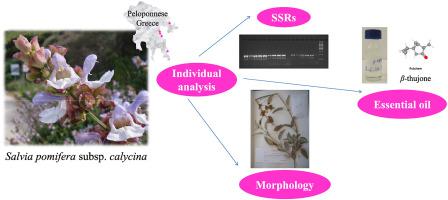Phytochemistry ( IF 3.2 ) Pub Date : 2021-08-14 , DOI: 10.1016/j.phytochem.2021.112900 Peggy Leontaritou 1 , Fotini N Lamari 2 , Vasileios Papasotiropoulos 3 , Gregoris Iatrou 1

|
Salvia pomifera subsp. calycina (Sm.) Hayek (Lamiaceae), is an Eastern Mediterranean element, which is used in traditional medicine and cuisine in the same manner as S. fruticosa Mill. and S. officinalis L.. The essential oil (EO) and the extracts of S. pomifera possess bioactive compounds with anti-proliferative, anticholinesterase, antioxidant, antiviral and antifungal properties. In this study, the chemical (EO), genetic (DNA microsatellites, SSRs) and morphological diversity of forty-nine individuals of Salvia pomifera subsp. calycina, originating from five natural populations of the Peloponnese (Greece) were determined, in order to explore the potential for successful breeding and to reveal tools and biomarkers for identification and authentication. Chemical and genetic analyses revealed high levels of variation both within and among populations, while morphological analysis mainly within populations. Essential oil yield ranged from 1.79 to 5.79 ml 100 g−1 dry wt, among individuals while β-thujone ranged from 6.04 to 64.75%. Consistency was found in the EO yield and composition of specific individuals, when sampled during the same period, for three consecutive years, while the analysis during spring and summer months showed differentiation that still retained individual's discrimination. Genetic analysis using SSRs showed that the observed population heterozygosity (Ho) ranged from 0.48 to 0.67, while high number of private alleles were revealed in all populations. Considerable genetic differentiation was observed among the three Salvia taxa (S. pomifera subsp. calycina, S. fruticosa, S. officinalis) (Fst values ranged from 0.27 to 0.48) and lower among S. pomifera subsp. calycina populations (Fst values ranged from 0.06 to 0.13). The great variation that was revealed in all measured traits, in combination with the demonstrated, genetically based, consistency of their EO yield and composition, advocates to a successful breeding, whereas SSR genotyping presents a strong identification and authentication tool.
中文翻译:

对遗传、形态和精油变异的探索揭示了丹参亚种鉴定和育种的工具。calycina (Sm.) 哈耶克
鼠尾草亚种。calycina (Sm.) Hayek (Lamiaceae),是一种东地中海元素,与S. fruticosa Mill一样用于传统医学和美食。和S. officinalis L.. 精油 (EO) 和S. pomifera的提取物具有生物活性化合物,具有抗增殖、抗胆碱酯酶、抗氧化、抗病毒和抗真菌特性。在这项研究中,Salvia pomifera subsp. 49 个个体的化学(EO)、遗传(DNA 微卫星、SSR)和形态多样性。花萼,来自伯罗奔尼撒(希腊)的五个自然种群被确定,以探索成功育种的潜力并揭示用于识别和认证的工具和生物标志物。化学和遗传分析揭示了种群内部和种群之间的高度变异,而形态分析主要在种群内。精油产量范围从 1.79 到 5.79 ml 100 g -1干重,在个体中,而β-thujone 的范围从 6.04 到 64.75%。连续三年在同一时期采样时,特定个体的 EO 产量和组成具有一致性,而春季和夏季月份的分析显示差异仍然保留了个体的辨别力。使用 SSR 的遗传分析表明,观察到的群体杂合度 ( H o ) 范围为 0.48 至 0.67,而在所有群体中都显示出大量的私有等位基因。在三种丹参类群(S. pomifera subsp. calycina , S. fruticosa , S. officinalis)之间观察到相当大的遗传分化(F st值范围从 0.27 到 0.48)并且在S. pomifera subsp. 中较低。calycina种群(F st值范围从 0.06 到 0.13)。在所有测量的性状中揭示的巨大变异,结合已证明的、基于遗传的、其 EO 产量和组成的一致性,提倡成功育种,而 SSR 基因分型提供了强大的识别和验证工具。

































 京公网安备 11010802027423号
京公网安备 11010802027423号